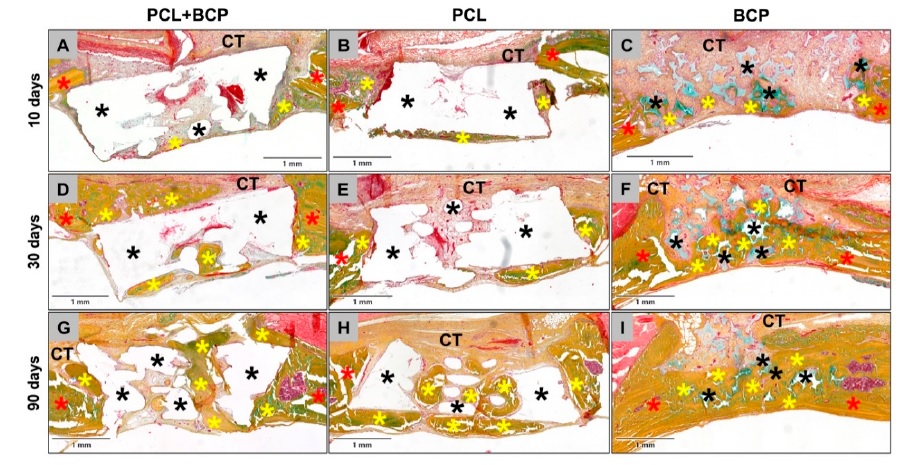In this method we describe the parameters to FDM bioprint scaffolds for Bone regeneration Composed by of 80% PCL that had a MW 80,000 (Polysciences Europe, Hirschberg an der Bergstraße, Germany) and 20% of the synthetic biphasic calcium phosphate bone substitute material (BCP) (synprint, ScientiFY GmbH, Berlin, Germany) with a particle size of <40 µm.
Printing filaments were produced by extrusion of the prepared pellets at 100 ºC (Noztek Pro, Noztek, Shoreham, England) with a diameter of 1.75 mm. The printing temperature was set at 130 °C for PCL + BCP, the platform/ printing bed heated to 30 °C, and the printer speed set to 5 mms−1.
Scaffolds were tested ex vivo for their mechanical properties using porous and solid designs. Subcutaneous implantation model analysed the biocompatibility of BCP and PCL scaffolds and compared with PCL alone (see citation).

Mechanical testing demonstrated no significant differences between PCL and PCL + BCP for both designs. Similar biocompatibility was observed subcutaneously for PCL and PCL + BCP scaffolds. In the calvaria model, new bone formation was observed for all groups with largest new bone formation in the BCP group, followed by the PCL + BCP group, and the PCL group.
The in vivo results show that BCP and PCL scaffolds are biocompatible and leads to successful osteoconductive bone regeneration.
This new biomaterial combines the structural stability provided by PCL with bioactive characteristics of BCP. 3D-printed BCP and PCL scaffolds provides an integration behaviour in accordance with the concept of guided bone regeneration (GBR) by directing new bone growth for proper function and restoration.
Equipment used:
- Noztek Pro, Noztek, Shoreham, England
- Bioprinter REG4Life, REGEMAT 3D, Granada, Spain
Citation:
Oberdiek, F.; Vargas, C.I.; Rider, P.; Batinic, M.; Görke, O.; Radenkovi´c, M.; Najman, S.; Baena, J.M.; Jung, O.; Barbeck, M. Ex Vivo and In Vivo Analyses of Novel 3D-Printed Bone Substitute Scaffolds Incorporating Biphasic Calcium Phosphate Granules for Bone Regeneration. Int. J. Mol. Sci. 2021, 22, 3588. https://doi.org/10.3390/ ijms22073588
| Number | Category | Product | Amount |
|---|---|---|---|
| 1 | - | Synthetic biphasic calcium phosphate bone substitute material (BCP)-PCL filament 1,75 mm in diameter -250 gram | 1 |


312 thoughts on “Bioprinting Scaffolds Incorporating Biphasic Calcium Phosphate Granules with PCL for Bone Regeneration”
Willkommen bei ‘KryptoKompass’, Ihrem ultimativen Leitfaden in der dynamischen und faszinierenden Bruise der Kryptowahrungen. Unser Blog bietet Ihnen aktuelle Nachrichten, tiefgehende Analysen und wertvolle Einblicke in bite the dust Contusion von Bitcoin, Ethereum, Wave und vielen anderen digitalen Wahrungen. Egal, ob Sie ein Anfanger oder ein erfahrener Investor sind, wir liefern Ihnen go to one’s final Informationen, go to meet one’s maker Sie brauchen, um fundierte Entscheidungen zu treffen. Tauchen Sie ein in unsere Expertenartikel, Tutorials und Marktprognosen, um Ihr Krypto-Wissen zu erweitern. Mit ‘KryptoKompass’ bleiben Sie immer auf dem neuesten Accept der Entwicklungen im Kryptoraum
[url=https://carsused.ru]carsused.ru[/url]